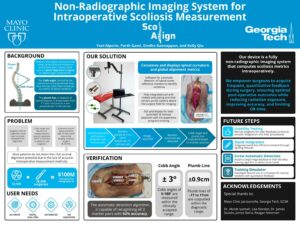Scoliosis is a lateral curvature of the spine in the coronal plane. In severe cases, scoliosis patients require spinal alignment surgery to correct their spinal curvature and balance. However, current methods for quantifying spinal alignment intraoperatively are time-intensive, radiation-based, and inaccurate. Surgeons currently have to rely on subjective visual cues to assess intraoperative alignment. Radiographic measurements can be harmful to patients and clinicians. They also add time and cost to the procedure.
Ultimately, most patients that undergo spinal alignment surgery are unable to attain their full coronal alignment potential through surgery because of the lack of convenient and accurate intraoperative measurement tools.
Yoel Alperin, Parth Gami, Sindhu Kannappan and Kelly Qiu comprise the Georgia Tech Spring 2021 Capstone Design Team ScolAlign. Their technology seeks to objectively improve the standard of care for intraoperative spinal alignment during scoliosis correction surgery.
ScolAlign, is a fully non-radiographic, intraoperative imaging system that computes metrics for scoliosis in a time-efficient manner. The device incorporates software for automatic detection of spinal screen reference markers to identify vertebrae, a fully integrated cart with a mobile articulating arm that centers an HD camera above the surgical field for imaging, a graphic user interface and display for both automatic and manual detection with intraoperative progress tracking.
“Our solution has the potential to empower surgeons to frequently acquire quantitative feedback during surgery, leading to improved post-operative patient outcomes,” Kelly Qiu wrote to us.
Verification testing needs specialized resources: Enter GCMI
To help verify the device’s accuracy for metrics of spinal curvature and balance compared to preoperative X-rays, GCMI provided the facilities and resources the team needed to conduct verification testing in a cadaveric model.
Through this testing, the team determined that its automatic detection algorithm is capable of recognizing all three ‘marker pairs’ placed at the most tilted vertebrae, C7 and sacrum with 92% accuracy.
“It was incredible to see our device in use on a cadaver, mimicking its functionality in an operating room,” Kelly wrote. “The staff at GCMI were incredibly helpful and the resources we had access to greatly helped advance our device’s verification testing.”
If the team forges ahead with the technology, the pathway includes voice of user testing, environmental integration, automatic screw detection capability development and training simulations.
The path to the summit is rarely ever a straight one
“We learned that the design process can be a lot less straightforward than identifying a problem and producing a solution,” she continued. “Even when our team had decided on a final design concept or ‘finalized’ our prototype, we kept finding new changes we wanted to make to continuously improve our device. Our team would give the advice of never being too set on an idea as you may often discover another approach that is more effective in solving the problem.
“We learned a lot of valuable skills from working on ScolAlign that ranged from more technical skills like learning to use computer vision and programming a user interface to soft skills like fostering a collaborative team environment and managing project deadlines. It was an incredible experience that showed us a fast-tracked version of the pathway to medical device development. The knowledge and skills we gained this semester will be useful as our team continues on our respective pathways in the medical field.”
You can watch the team’s 2021 Spring Capstone Design Expo presentation here.

GCMI congratulates the team on its important work and wishes each member all imaginable success in their future endeavors.
GCMI’s mission is to bring new medical technologies to market that improve quality-based outcomes and delivery of care for patients worldwide. This certainly includes supporting development of medical technologies born in our backyard from faculty, researchers and students with whom we share our institutional affiliation. We congratulate the 2021 Spring Capstone teams and eagerly anticipate what the Fall 2021 teams have to show us later this year.
